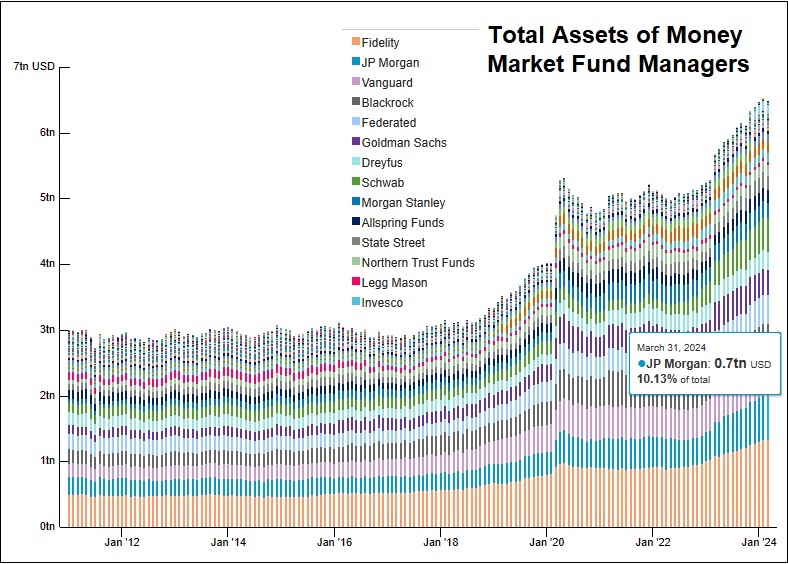Fed Announces $60 Billion a Month in Repos
Tip of the Iceberg: Emergency Repos Stretch to 2020 Q2
by Mish Shedlock, The Maven:

New York Fed on Twitter
“The FOMC directed the Desk, effective Oct 15, to purchase T-bills at least into Q2 2020 to maintain ample reserve balances at or above…
twitter.com

New York Fed on Twitter
“Term repos will generally be 2x/week, initially in an offering amount of at least $35B per operation. Overnight repos will be daily,…
twitter.com
In a term auction today, the Fed did $61 billion.
Tip of the Iceberg
The emergency repo auctions to get through the quarter end on September 30 have been extended and added to.
Today, the Fed announced it would add roughly $60 billion a month through the end of the second quarter of 2020.
Please consider the Repo Market Incident May Be The Tip Of The Iceberg by Daniel Lacalle.
The Federal Reserve has injected $278 billion into the securities repurchase market for the first time. Numerous justifications have been provided to explain why this has happened and, more importantly, why it lasted for various days.
The first explanation was quite simplistic: an unexpected tax payment. This made no sense. If there is ample liquidity and investors are happy to take financing positions at negative rates all over the world, the abrupt rise in repo rates would simply vanish in a few hours.
Sudden bursts in the repo lending market are not unusual. What is unusual is that it takes days to normalize and even more unusual to see that the Federal Reserve needs to inject hundreds of billions in a few days to offset the unstoppable rise in short-term rates.
What the Repo Market Crisis shows us is that liquidity is substantially lower than what the Federal Reserve believes, that fear of contagion and rising risk are evident in the weakest link of the financial repression machine (the overnight market) and, more importantly, that liquidity providers probably have significantly more leverage than many expected.
In summary, the ongoing -and likely to return- burst in the repo market is telling us that risk and debt accumulation are much higher than estimated. Central banks believed they could create a Tsunami of liquidity and manage the waves. However, like those children’s toys where you press one block and another one rises, the repo market is showing us a symptom of debt saturation and massive risk accumulation.
QE is Back
Lacalle notes Quantitative Easing Is Back
The Federal Reserve, through its president Jerome Powell, has indicated that it is preparing to increase its balance “organically”. The effort to separate this latest monetary policy change of course from a full-blown new QE (quantitative easing) is, at the very least, amusing. If we look at what is being discussed, it has nothing to do with organic expansion and looks a lot like a new repurchase program.
What the Fed proposes has very little to do with organic expansion. The Quantitative Easing programs repurchased between 60 to 85 billion dollars in assets per month. If we look at the organic growth of the Federal Reserve balance sheet prior to quantitative easing, it barely reached 3 billion dollars in a month. The Federal Reserve is discussing between 200 and 300 billion per quarter. That is not organic expansion but it is neither the type of measure that would trigger a surge in risk appetite from financial agents. So it is quite a lot more than organic expansion and also a lot less than what beta-chasing investors may require to keep their negative dollar carry-trade on cyclical assets.
This is a measure that will not satisfy those who need more excess liquidity and more stimuli to continue playing against the dollar but, at the same time, it further distances the Federal Reserve from normalization. If we assume the figures mentioned in different sources, the Federal Reserve balance sheet is unlikely to go below 25% of GDP in the next years.
The average investor may find contradictory messages in the Fed statements. Powell confirms that the economy is growing at a good pace, that unemployment is at the lowest level in 50 years and that core inflation remains above the Federal Reserve threshold, yet they also tell us that they have to cut rates and expand the balance sheet. Something does not match, and the explanation may lie in the need to keep an excessively leveraged market afloat and prevent the chain of bubbles in financial assets from bursting.
To me, these apparent contradictions in communication mean that the Federal Reserve is looking to prevent a financial asset meltdown while at the same time trying to avoid a higher concentration of risk. It may be, again, trying to manage the waves in the tsunami.
Supposedly Not QE, Not Monetary Policy
The Fed says these injections are not QE and not related to monetary policy.
Both statements are lies.
Loading...




